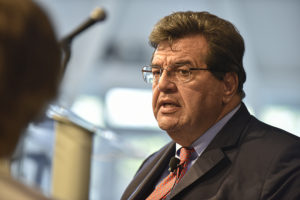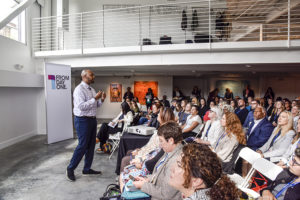Why Genuine Diversity Includes People With Disabilities


“My phone doesn’t stop ringing with customers because they want to know what we’re doing,” said Jim Sinocchi, a top executive at JPMorgan Chase. However, unlike most callers who ring up the largest U.S. bank, their curiosity had nothing to do with money. It had to do with people—people with disabilities.
Sinocchi, who leads Chase’s global Office of Disability Inclusion, has been part of a concerted effort by the bank to expand its diversity hiring to include more people with disabilities, an aspect of recruiting that has tended to lag behind progress on gender, color and sexual orientation.
Sinocchi, speaking at the From Day One conference in Boston last month, told the audience about his personal journey with a disability, his three-decade crusade to broaden rights for the disabled in the workforce, and the breakthroughs he has helped achieve at the bank.
Sinocchi, 63, has been a quadriplegic since a body-surfing accident in Puerto Rico when he was 25. He returned to his job at IBM after 17 months of rehabilitation and rose to executive positions in marketing and communications roles. Several years go, the married father of two retired from IBM, but before long, another Fortune 500 company, Chase, recruited him to be the leader of its new global campaign of inclusion.
Since Sinocchi took on the groundbreaking role, JPMorgan Chase has hired thousands of disabled workers, identified new opportunities for the developmentally disabled, and increased the conversation around disability to the point that the percentage of workers who feel comfortable identifying as disabled has doubled, to 3.2%.
“It’s a small change, but it’s a change,” Sinocchi told Carina Livoti, From Day One’s director of content, during a one-on-one conversation. “And that means, to me, that the culture is changing.”

Changing that culture meant educating managers and recruiters about understanding disabled people, looking for opportunities to match jobs to people, and encouraging and helping disabled workers to seek leadership opportunities.
“People are afraid to touch disabled people,” Sinocchi said, explaining that training and education can help normalize interactions between the disabled and able-bodied, who often wonder what to say to disabled people when a simple ‘Hello’ or ‘Would you like a cup of coffee?’ would do just fine.
“I’d like to try to demystify this for folks,” Sinocchi said. “It starts to catch on [when we] realize we have more in common, as disabled people, with able-bodied people than we thought.”
He added: “That’s what I ask our managers to think about, and what I ask people that engage with us to think about … all of a sudden, it dissipates.”
He said: “I have an 80/20 rule. [It] goes like this: If you’re a manager, you usually get resumes and bios to hire people. Why is it that, when a person with a disability walks into the job–after you call them in after reading their bio–why are you skittish?
Sinocchi continued: “Every manager brings in a person after reading a bio because they have 80% of what they need to do the job. What us managers have to do is teach that person the 20%. That’s no different, whether you’re disabled or not, because you already accepted the bio from the person that was blind or deaf or sitting in a wheelchair. You just have to teach that person 20%.”
While changing attitudes and culture has been key to JPMorgan Chase’s success, Sinocchi said, strategic financial decisions have also been instrumental. Budgets for buying or providing accommodation–such as automatic doors, Sinocchi said–were “held at the top of the business” so the manager would not have to worry about moving around money. Company-wide accommodations were also implemented, he said.
And describing what he called the “beauty of the firm,” Sinocchi further lauded JPMorgan Chase’s top-down commitment, adding that CEO Jamie Dimon “had his hands all over this deal to make it work.
“And if it works from the top, it’s going to work throughout the corporation,” Sinocchi said.
But, he admitted, there was still some need for employees to speak up and tell managers about other accommodations that could make everyone’s lives easier. And disabled workers must be supported and encouraged to pursue their ambitions to take on bigger responsibilities, Sinocchi said.
“I tell them, disabled employees, you have to own your disability,” Sinocchi said during the chat. “People with disabilities have this aura … where you feel less-than, you’re not going to be accepted. So if I can get my talented people with disabilities to come out and step out,” they will be available to an opportunity that might pass them by, he said. “No one’s going to call you out and say, ‘Hey, Mary, do you want to be a vice president today?’”
“That never happens unless you go hard or you’re brilliant … The idea is, how do you position yourself for success unless you step up and convince your manager that you can be a leader? What I think about is not only hiring people, but how you get people into a leadership position.”
Sinocchi emphasized that advances in technology and medicine have helped level the playing field somewhat for the disabled, but he pointed to the need for continued education, communication and innovation.
“I think there’s no excuse not to hire people” with disabilities who can do the job, he said. “This is a great work force. Our attendance is high; we don’t have the medical issues we used to have, with the better care. People with disabilities are loyal; they want to work–and it’s a great area to look at.”
Strives are also being made in identifying niches within the workforce where people with certain disabilities may excel, Sinocchi said. “In the last year, we’ve looked for work that can be better served by the developmentally disabled population,” he said. “For the first two years, we didn’t bring in anybody with developmental disabilities because I didn’t know what we had … but what we found out is, there were certain jobs that able-bodied people do poorly.”

He pointed to roles such as testing mortgage applications or other tasks that require a kind of hyper-focus and tenacity, which tend to be well-suited for people on the autism spectrum, he said. Chase’s innovation and research looked at “matching work to people,” said Sinocchi, admitting that “it’s a slow process.”
He said: “I don’t think we can take everybody with a disability, but we can take people who are qualified for certain jobs and give them the accommodations they need to do it.”
Disability inclusion can benefit all of a company’s stakeholders, he said, including employees and customers. “It brings people to us,” Sinocchi said, “and it makes our teams try to figure out how much more we can move the bar with the right technology to get these people to work.”
In a workshop earlier in the day, Willie Jackson, a diversity, equity, and inclusion consultant at ReadySet, focused on ally skills, which can position people of color and their colleagues to successfully undertake allyship at work and beyond.
Sheila Flynn is a New York-based journalist who has written for DailyMail.com, the Irish Daily Mail, and the Associated Press. She is a graduate of the University of Notre Dame
The From Day One Newsletter is a monthly roundup of articles, features, and editorials on innovative ways for companies to forge stronger relationships with their employees, customers, and communities.